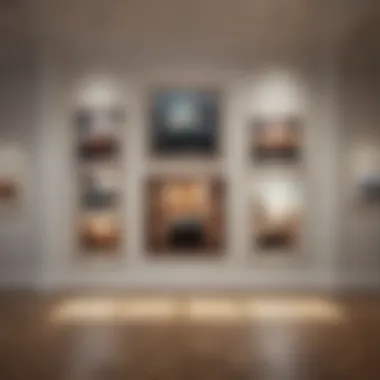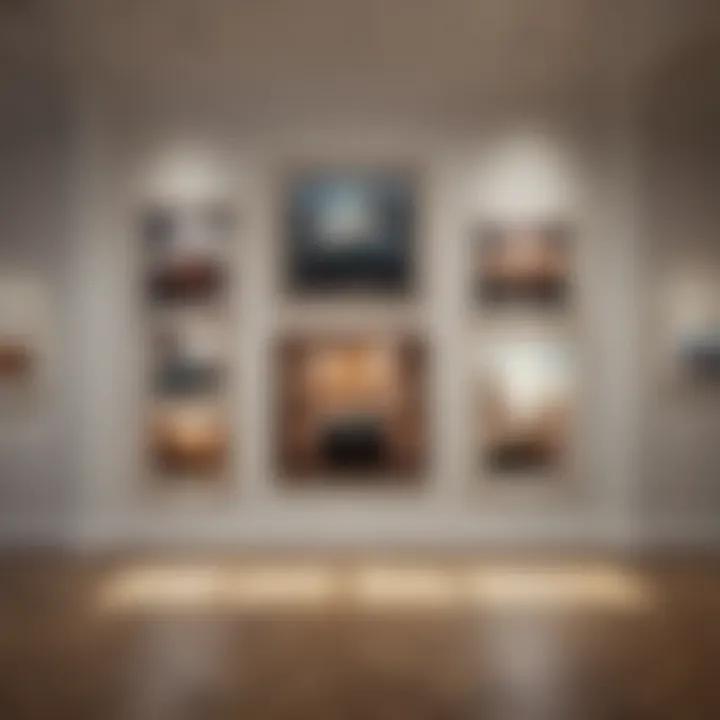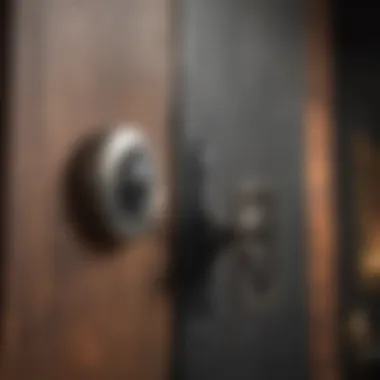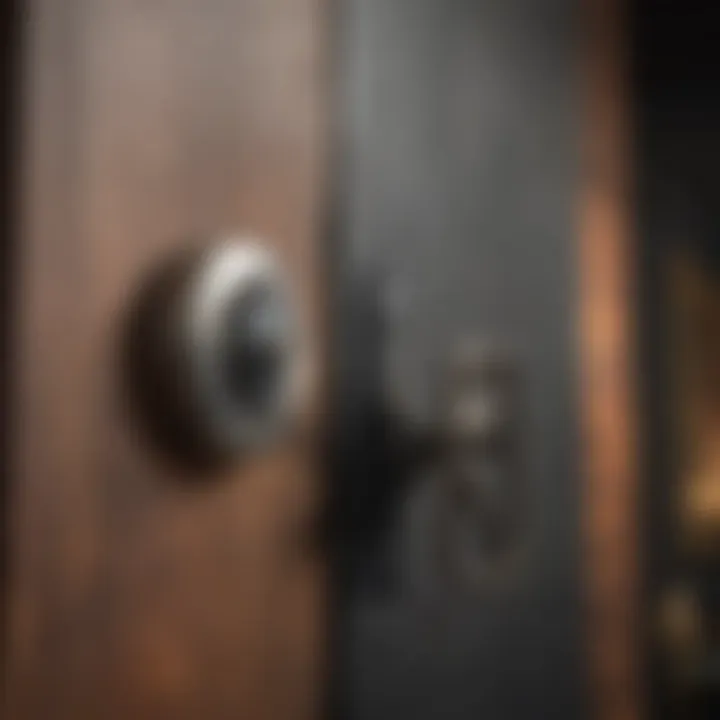Techniques for Hanging Large Art Effectively


Intro
Hanging artwork, particularly large pieces, can often feel like threading a needle in a haystack. It requires not only a good eye for aesthetics but also an understanding of both spatial dynamics and practical techniques. Knowing how to effectively display large art can turn a plain wall into a focal point, transforming an ordinary room into an extraordinary space. This comprehensive guide delves into essential strategies that help in the selection, placement, and hanging of large art pieces, ensuring they not only attract attention but also blend seamlessly with the overall interior design.
In the following sections, we will explore key aspects such as the ideal location for your art, the different wall types you might encounter, and the importance of necessary tools and hardware. We will also tackle common missteps and provide solutions to overcome them. Let’s get started on making your art collection shine!
Home Features
Hanging large art pieces can dramatically enhance the features of a home. Understanding the architectural nuances of your space can lead to a more harmonious and aesthetically pleasing arrangement.
Architectural Marvels
When considering where to hang your art, take a moment to assess the architectural characteristics of the room. High ceilings paired with expansive walls create a prime opportunity for larger pieces. Think of using oversized art as a statement piece on a feature wall. It draws the eye and creates a sense of grandeur. Conversely, a smaller piece may get lost in the vastness, becoming just another decoration. Aim for contrast; massive art on tiny walls can feel overwhelming, whereas smaller art can complement and enhance the architectural charm of the space.
Unique Design Elements
Different homes come equipped with unique design elements that influence where and how you hang your art. Consider bright mantelpieces or built-in shelves that could serve as a backdrop, framing your art in an engaging way. Moreover, architectural details like doorways, windows, or even architectural moldings propose strategic spots for vertical or horizontal arrangements. Utilize these elements to guide your decisions, making your art feel intrinsic to the space rather than an afterthought.
Interior Design Inspirations
Once you’ve navigated through the home features, the next step is to pay attention to interior design inspirations that help curate the environment around your art pieces. Thoughtful arrangements can significantly amplify the impact of your artwork.
Color Palettes and Themes
Choosing the right colors can enhance the overall vision of your space. Pay attention to the hues in the artwork and how they interact with the wall color. The art should pop or elegantly blend with its surroundings, depending on your intention. When hung against a neutral backdrop, vivid art takes center stage, while softer palettes create a more understated elegance. Feel free to use art as a springboard for choosing room colors—match pillows, curtains, or even wall paint to the colors found in your artwork for a cohesive look.
Furniture Arrangement Tips
The positioning of your furniture also plays a vital role in how the artwork is perceived. Keep traffic flow in mind to ensure that the art doesn’t become a stumbling block or overly distracting. Try to arrange seating in a way that allows for easy viewing of the artwork. Additionally, consider using furniture to frame the art—placing a console table underneath a large piece or adjusting the arrangement of chairs can create a more intimate, curated atmosphere.
Art enables us to find ourselves and lose ourselves at the same time.
As we navigate through the practical steps of hanging large art in the subsequent sections, remember, integration with existing elements and thoughtful placement is key. Properly considered, these large pieces can not only serve as eye-catching highlights but also as storytelling elements within your interiors.
Prelude to Hanging Large Art
Hanging large art is not just about slapping a piece on the wall and calling it a day. It requires much thought and precision. The way art is presented can have a significant impact on any space, influencing the mood, the traffic flow, and even the perceived size of a room. This is particularly true for large art pieces that can dominate a space, both visually and physically.
When you hang a large artwork, it is imperative to consider several elements like placement, balance, and even light. These factors dictate not only how the art will complement the existing decor, but also how it will affect the environment overall. Poorly hung art can throw a room off balance, making it feel chaotic or mismatched. Conversely, well-placed art can transform an ordinary space into something extraordinary, creating focal points that draw the eye and spark conversation.
In this guide, we'll not only explore the practical techniques of hanging large art but also dive into the aesthetic considerations that can elevate the overall design of any room. From choosing the right tools and hardware to understanding the importance of height and alignment, every detail matters.
This knowledge doesn’t only benefit the art lover but also anyone involved in interior design, real estate, or simply maintaining a pleasant living environment. Art is more than decoration; it tells a story and breathes life into walls.
"Art is the most beautiful of all lies."
– Claude Debussy
Thus, as we move forward in this comprehensive guide, it is essential for the reader to embrace both the challenges and the immense rewards that come with hanging large, impactful art pieces. Taking the time to plan, measure, and thoughtfully execute can make all the difference in showcasing art successfully.
Understanding the Significance of Art Placement
When it comes to hanging large art, the placement of the piece plays a crucial role in how it interacts with the surrounding space. Proper art placement transcends mere aesthetics; it fundamentally transforms the vibe of a room and influences how viewers engage with the artwork. The message a piece conveys can significantly change based on its environment. This part of the guide sheds light on the value of strategically placing art, focusing on various benefits and considerations.
Creating Visual Balance
Visual balance is essential in any well-designed space. When large art pieces are hung, they can either harmonize with their environment or disrupt the visual flow. Think of it as a dance – each element in the room needs to work in concert to create a pleasing outcome.
To achieve visual balance, one can consider the weight distribution in a room. A massive painting hung above a sofa could be too heavy if it's not countered by lighter elements nearby, like sculptures or smaller artworks. The goal is to avoid creating a visual tug-of-war in the space.
- Focal Points: Large artwork often acts as a focal point. Understanding where the eyes naturally fall can dictate where to place these pieces.
- Negative Space: Giving the artwork room to breathe by allowing for negative space can enhance its impact, making the surrounding elements feel balanced.
- Color Coordination: Utilizing color palettes that compliment or contrast the art can add a layer of depth and interest to the room.
Enhancing Space Functionality
The functionality of a space is fundamentally intertwined with art placement. When large pieces are thoughtfully arranged, they don't just beautify a room—they enhance how the space is used and perceived. Take, for instance, the way art can define areas within an open floor plan.
Not every space can afford the luxury of art just "plopped" down anywhere. Here’s where the smart placement comes into play.
- Zoning: In larger spaces, artworks can delineate zones, helping to establish areas for relaxation, entertainment, or work. A striking abstract piece can anchor a conversational area, making it feel intimate.
- Inspiration and Mood: Integrating art that resonates with the purpose of the space can amplify its function. A serene landscape in a bedroom encourages relaxation, while vibrant, dynamic pieces in a home office can stimulate productivity.
- Flow and Cohesion: Art can also guide movement throughout a room. Placing larger pieces in strategic spots can create a coherent flow and lead the eyes from one area to another, enhancing how spaces interact with one another.
Taking these factors into account when deciding how to display large artworks helps steer clear of common pitfalls and maximizes both aesthetic appeal and practical use. Art is more than decoration; it shapes our experiences and interactions within spaces.
"The beauty of art lies not in its isolation but in how it connects and transforms its surrounding world."


By thoughtfully considering these elements, anyone can bring their art to life, ensuring it plays a pivotal role in the story of the space.
Selecting the Right Space for Large Art
Choosing the right space for hanging large art is more than just picking a wall; it’s about creating an atmosphere that allows the artwork to shine. An ideal location highlights the art and complements the room's overall design. It’s crucial to consider how large pieces can influence the dynamics of a space. If hung properly, they can transform an area, while a poor placement could diminish their impact.
Evaluating Room Size and Layout
When evaluating where to place your large piece of art, the size and layout of the room must be taken into account. A spacious living room might seem like a perfect canvas, but a huge wall can easily overwhelm a small artwork. Conversely, in a snug space, a large art piece can create an inviting focal point. Here are key aspects to consider:
- Scale: Ensure that the artwork complements the dimensions of the room and does not crowd existing furniture.
- Placement: Avoid corners or cramped areas; instead, aim for central walls where the art can be appreciated from various angles.
- Sight Lines: Think about how people move through the space and position your art to catch attention naturally.
Ultimately, keep the layout in mind—will that piece invite conversation or add a layer of interest to your decor?
Considering Natural and Artificial Light
Light plays a pivotal role in how we perceive art. Without proper lighting, even the most exquisite paintings can look dull. Therefore, assessing the light in your chosen space is essential. Here’s what to keep in mind:
- Natural Light: Too much sunlight can fade colors, while too little can make the art appear lifeless. Positioning art near windows can offer vibrant viewing experiences, but use UV-filtering glass or curtains to safeguard against damage.
- Artificial Lighting: Consider using spotlights or wall washers to enhance the art’s features. Adjusting the color temperature of bulbs can significantly improve how the artwork is perceived. Think of how shadows may play on the surface too.
- Complementing the Piece: Light should accentuate rather than obscure details. Warm tones often work well in traditional spaces, while cooler lights can enhance modern art.
Understanding Wall Types and Condition
The type of wall you choose greatly impacts how effectively you can hang large art pieces. Here’s how to assess your options:
- Material Consideration: Some materials, like drywall or plaster, are easier to work with than brick or concrete. Also, consider the wall’s load-bearing capacity, as heavier pieces will require sturdier support.
- Condition of the Wall: A well-maintained wall provides a better backdrop for larger art. Cracks, holes, or peeling paint can detract from the art and should be addressed before installing anything. Fresh paint or a neutral background can also make your piece pop.
- Textured vs. Smooth: Textured walls can create visual tension with flat art pieces, while a smooth wall allows a seamless integration.
In summary, selecting the right space for large art is more than choosing a wall; it’s about creating a harmonious relationship between the artwork and the environment. Taking into account room size, lighting, and wall conditions ensures that the piece not only fits but flourishes in its designated space.
"The art of placement is as important as the art itself. If the space is not right, even the finest pieces can fail to resonate."
By paying attention to these details, your large art installations can transform any room into an inspiring gallery.
Tools and Hardware for Hanging Large Art
When it comes to hanging large art, having the right tools and hardware is not just helpful; it’s essential. You're looking at not only aesthetic appeal but also the structural integrity of the piece you're displaying. Think of tools and hardware as the backbone of your art-hanging efforts. They can make the difference between a piece that stands proud on the wall and one that ends up crashing to the floor. Choosing the correct hardware can set you up for success, ensuring your valuable artwork remains secure and in place for years to come.
Understanding the types of tools and hardware available, and their distinct features, can also save you a world of trouble down the line. This section is designed to walk you through the essentials, from the tools that help with positioning to the various hardware choices suited for hanging large pieces securely.
Essential Tools for Art Hanging
Art hanging doesn’t require an entire toolbox full of gadgets, but a few key tools can make all the difference. Let’s break it down:
- Tape Measure: Precision is the name of the game. A tape measure ensures you get the spacing right on your wall, helping you visualize where that masterpiece should go.
- Level: No one wants a tilted Picasso. A level guarantees that your piece hangs straight, giving your space an elegant finish.
- Pencil: Simple but crucial. A pencil is perfect for marking spots for your hardware without leaving permanent marks.
- Hammer or Drill: Depending on your wall type, you’ll need either a hammer for nails or a drill for screws. Choose wisely based on the art’s weight.
- Stud Finder: If your wall is made of drywall, a stud finder will help you locate the sturdier parts of the wall to ensure stability.
Having these tools at your side makes the hanging process smoother and reduces the pressure when it comes time to display your large art pieces.
Choosing the Right Hardware
Selecting hardware is like picking the right shoes for a hike – you want something that suits the terrain and gives you confidence in each step. With hanging large art, there are a few commonly used hardware options to consider.
Picture rails
Picture rails are somewhat of a hidden gem in the world of art hanging. They consist of a strip mounted near the ceiling, to which you can attach wires or cords for your artwork. The ability to hang art without permanently damaging your walls makes this an attractive option.
- Key Characteristic: The most notable aspect of picture rails is their flexibility. You can arrange art at different heights without the hassle of hitting the wall with nails repeatedly.
- Benefits: They also allow for easy changes of artwork, which is perfect if you love to switch things around to keep the decor fresh.
- Disadvantages: On the downside, picture rails can be somewhat costly to install, and not all interiors feature them. If you are not careful during installation, it can also lead to damage if the rails do not support the weight properly, so it requires a bit of expertise.
D-ring hangers
D-ring hangers are a traditional choice for many artists and homeowners alike. These small metal fittings attach to the back of the frame and provide an easy way to hang pictures.
- Key Characteristic: The simplicity and effectiveness of D-ring hangers cannot be understated. They come in various sizes and can fit a range of artwork weights.
- Benefits: They are also fairly easy to install and provide strong support for your pieces, making them a go-to choice for many.
- Disadvantages: One potential drawback is that they can sometimes leave marks or faint lines on the wall if removed frequently, depending on how firmly they are pressed against the surface.
Wall anchors
For those hanging pieces on drywall, wall anchors are crucial. They prevent the art from being just a paperweight on the floor instead of hanging beautifully on the wall.
- Key Characteristic: Wall anchors provide added support for screws when hanging heavier items, spreading the load over a broader area.
- Benefits: This makes them highly reliable for big pieces. They also come in various types, such as toggle bolts or sleeve anchors, to cater to different weights and wall conditions.
- Disadvantages: However, they can require a bit more installation time, sometimes needing tools beyond a standard drill, and can cause a bit more damage to walls when removed as they typically leave a hole.
With these tools and hardware options at your fingertips, you’re well-equipped to take on the art hanging task. The right combination not only saves you headaches later but can enhance the visual ambiance of your space significantly.
Measuring and Marking the Wall
Measuring and marking the wall is a critical step in hanging large art. This part of the process lays the groundwork for ensuring that the artwork is positioned perfectly within any given space. Failing to take careful measurements can lead to a disheveled look that detracts from the art’s intended presentation. Moreover, it's not just about spatial considerations; it’s about creating an experience that resonates with viewers.


Determining Ideal Height
When it comes to determining the ideal height for hanging art, there's a bit of an art to it—pun intended. Ideally, the center of a large artwork should be at eye level to ensure it’s easily appreciated. This height can vary depending on the space and the average height of the people who use that space. The concept of eye level often hovers around 57 to 60 inches from the ground. This standard is favored because it aligns most effectively with human sightlines, making the art perceptibly engaging without requiring craned necks or bent knees.
Eye level recommendations
Eye level recommendations contribute significantly to achieving visual harmony in any space. A key characteristic of this approach is its universality; it’s based on the average person's eye level, which is relatively consistent across diverse environments. By adhering to this general height, the art piece can achieve better balance with surrounding decor. The unique feature of eye level positioning is its subtlety—it allows the art to blend seamlessly into the environment while drawing attention without overshadowing other elements in the room. However, one disadvantage could be that in spaces with varying ceiling heights or when the art is large, adjustments may be necessary to accommodate the flow and proportion of the room.
Adjustments for furniture
Adjustments for furniture play a pivotal role in ensuring that artwork complements rather than clashes with existing furnishings. As such, it’s essential to consider the types of furniture in the vicinity. The key characteristic of this aspect lies in functionality; positioning art too high or too low can create a disjointed experience, making the space feel cluttered or chaotic. In effect, this adjustment allows for an integrated look that enhances the overall design. The unique feature here is that it encourages a personalized touch—art becomes part of the furniture, conversing with its surroundings. Yet, this can be a double-edged sword, where improperly gauged adjustments could lead to a lack of visual focus or obscure the details of the artwork altogether.
Aligning with Other Elements
When hanging large art, aligning it with other elements in the room is essential for a cohesive display. This is especially true when incorporating multiple pieces or various forms of decor. Maintaining a sense of flow and rhythm is vital.
Groupings of art
Grouping art can create a dynamic and engaging aesthetic that draws the eye across the display. The key characteristic of this method is its versatility—it can range from a tight cluster of works to a looser arrangement that allows for breathing space. Choosing to group art encourages a layered and deliberate presentation, as the pieces often play off one another. However, one must tread carefully; if not achieved with clarity, groupings can become chaotic, making it difficult for any single piece to shine.
Other wall decor
Integrating other wall decor, such as shelves or mirrors, enhances the overall visual impact of large art pieces. It allows for a richer narrative to unfold on the wall—each piece of decor adding its own chapter. The key characteristic of this approach is the ability to create focal points; it transforms a singular piece into part of a holistic experience. The unique feature here is how various elements can reflect, contrast, and complement the artwork. That said, too much decor around a large art piece can distract from its significance, so finding the right balance is essential.
"A well-measured wall is like a well-tuned instrument; harmony lies in the details."
By understanding the importance of measuring and marking the wall, homeowners can better appreciate their artwork and maximize their space.
Hanging Techniques for Large Art
When it comes to displaying large art pieces, the hanging techniques you choose can significantly affect the overall impact and aesthetics of your space. Understanding these techniques not only helps you avoid common pitfalls but also enhances the visual appeal of your artwork. A well-hung piece becomes a focal point, setting the tone for the entire room. It’s the difference between making a statement and simply filling a vacant wall.
Choosing effective hanging methods acknowledges that art isn't just decoration; it’s how we express culture, feelings, and even personal history. Whether it’s a striking modern painting or a classic tapestry, how you hang it plays a crucial role in how it's perceived. There’s a unique satisfaction from seeing art showcased properly, allowing it to breathe and shine in its designated space.
Single Piece Hanging
Hanging a single large piece may seem straightforward, but it requires careful consideration. First up is the height at which you hang it. Ideally, the center of the artwork should be around 57 to 60 inches from the floor. This height coincides with an average eye level, making it comfortable for most viewers.
Consider the surrounding area as well. A stunning piece can feel lost if surrounded by clutter or if hung too high or low. You want that piece to command attention without overwhelming the room. Additionally, assess whether the art will be viewed solo or in conjunction with furniture. An area over a sofa, for instance, needs to harmonize with the seat height, creating a visual relationship
Gallery Wall Arrangement
Creating a gallery wall is an exciting technique that showcases a collection of artworks, allowing you to express personal taste and creativity. This method involves grouping smaller pieces in a cohesive arrangement, which can be playful yet structured.
To kick off, lay your items on the floor. Get a sense of how they fit together without committing to holes in your wall yet. A mix of frame styles and colors can add character. Here’s a tip: start with your focal piece and build around it, ensuring balance in shape and color. Make sure larger works are not next to smaller ones; keeping proportion in mind helps maintain harmony.
Using a level can help ensure your pieces are straight, but sometimes it's the slight imperfections that lend charm and character. Aim for a cohesive feel instead of matching everything perfectly. Adding in some negative space can also give the eye a chance to breathe.
Using Lifts and Assistants
Hanging large art is often a two-person job, especially if you're dealing with bulky frames or heavy materials. Using lifts can ease the process significantly. Whether it’s a rented lift or a homemade scaffold, making sure you can reach higher places safely is crucial.
An extra set of hands can provide much-needed support, allowing one person to hold the artwork in place while the other secures it. Take your time during this step; rushing can lead to misalignment or, worse, accidents. Each holder should communicate what they see to avoid confusion, ensuring both parties are on the same page.
Whether it’s a hefty canvas or an oversized metal piece, utilizing tools effectively saves you from backaches later on. Plus, considering safety must be a priority. It’s better to take additional time than to risk damaging the art—or worse, injuring yourself.
"The right placement can transform a regular room into a gallery; making art not just something to see, but a part of life."
Common Challenges When Hanging Large Art
Hanging large artworks poses unique challenges that can trip up even seasoned enthusiasts. Navigating these hurdles effectively is essential not only for the integrity of the artwork but also for advancing the overall aesthetic appeal of a space. Understanding these challenges can save time and frustration, ensuring that every art piece is showcased appropriately and securely. It's not simply about slapping a nail in the wall; there’s a subtler art to it.
Identifying Wall Flaws
Before diving into the hanging process, it’s crucial to examine the walls themselves. Sometimes, you might find cracks, bumps, or uneven surfaces that can disrupt the visual harmony of a large art piece. It might seem like a tedious task, but recognizing these flaws before you start can make a world of difference.
- Cracks and holes can often undermine the weight distribution. If you can spot these issues prior to hanging, you might avoid disaster down the line.
- Uneven drywall can give an impression that the artwork is misaligned or worse, tip over time. Using a level can assist in determining flatness.
- If the walls are painted in a color that doesn’t harmonize with the art, consider repainting or making adjustments in terms of placement.
In essence, make wall diagnostics an initial step in your project. It not only enhances the appearance but also aids in preserving the art itself.
Dealing with Weight Issues
Weight can be the elephant in the room when hanging large art pieces. Larger works typically come with higher weight, which necessitates a thoughtful approach to the hardware and mechanisms used. Standard picture hangers might not suffice; it’s essential to consider specialized solutions.


- Using appropriate anchors is vital; regular nails might come with a risk.
- Consider wall studs: locate these using a stud finder to secure heavier artwork. This will help in preventing any embarrassing falls.
- For exceptionally oversized pieces, getting professional advice on weight distribution and using wall systems designed for larger displays can be beneficial.
Addressing weight issues from the outset not only saves hassle on the back end but helps maintain the artwork’s condition over time.
Addressing Frame Stability
The way an art piece is framed can have a significant impact on discussions surrounding stability. An unstable frame can lead to the artwork bowing over time, which is clearly not what you want after all the effort of putting it up.
- Check the frame material: Ensure it’s sturdy enough to support the artwork. Wooden frames tend to be more stable than metal counterparts, especially in larger sizes.
- Secure all sides: Double check that every side of the frame is firmly secured, particularly if it’s been constructed from multiple pieces. Loose components can jeopardize the integrity of the piece.
- Finally, consider how the art interacts with heat and moisture. Sometimes, frames that are subjected to these elements can warp, negatively impacting the display.
In summary, being vigilant about frame stability ensures your artwork will remain a centerpiece for years to come, rather than a source of anxiety.
Maintenance and Care for Art in High Places
Hanging large artwork can instantly elevate the atmosphere of a room, but it also comes with the responsibility of maintaining and caring for these pieces, especially when they are placed high on walls. Regular maintenance is crucial for preserving the artistic integrity and visual appeal of these artworks. Keeping art in pristine condition not only ensures that they look their best but also protects your investment.
Regular Inspections
Regular inspections of your art pieces help you catch any potential issues before they escalate into bigger problems. It's wise to take a step back and examine your artwork at least once a month. Look for signs of deterioration like fading colors, warping frames, or settling dust.
Inspecting can be quite uncomplicated. You don’t necessarily need a ladder if the piece is at eye level. Use a mirror if needed to check areas that might be out of direct sight.
Here’s what to keep an eye on during your inspections:
- Color shifts or fading: Check if sunlight is leaching color away.
- Physical condition: Look for cracks or chips in frames.
- Alignment: Make sure the piece hasn’t shifted, especially after seasons of heavy weather.
Being proactive with your art helps maintain its value over time. A well-functioning piece not only pleases the eye but also keeps those around it engaged and inspired.
Dusting and Cleaning Techniques
Dust and dirt accumulation can detract from the beauty of your artwork. Depending on the material of the artwork—be it canvas, paper, or a highly textured surface—the cleaning method may differ.
Here are a few effective dusting and cleaning techniques:
- Microfiber cloths: These work wonders for gently dusting frames and surfaces without scratching.
- Soft brushes: For textured pieces, gently use a soft brush to eliminate dust in the crevices.
- Avoid moisture: Never directly spray cleaning solutions onto the artworks. Instead, spray the cloth first to prevent any potential damage.
"Regular maintenance ensures that your artwork remains a source of joy and admiration, reflecting your personality and style."
By incorporating simple cleaning and inspection routines, you can ensure that your large artworks remain vibrant and captivating features of your space. Maintaining these artistic pieces will save you a ton of hassle and keep your walls looking lively, free from grime that could dull their charm.
Showcasing Art in Different Interiors
Showcasing art in a living space is not just about slapping a piece on the wall and calling it a day. It's about the ability to complement and enhance the interior's aesthetics while also reflecting the personality of its inhabitants. Achieving this balance requires an understanding of how different styles of décor influence the perception of large art pieces. When art harmonizes with its surroundings, it doesn't simply hang; it resonates. Here, we'll explore how to effectively display artworks within diverse interior styles, ensuring they contribute to the overall atmosphere rather than detract from it.
Modern and Minimalist Spaces
In modern or minimalist interiors, the mantra is often less is more. These spaces typically prioritize clean lines and neutral palettes, allowing for a few impactful elements to shine. Here, large art can play a pivotal role, breaking the monotony while still adhering to the minimalist ethos.
- Color Palette: Selecting art that incorporates soft or muted tones can seamlessly blend with the understated elegance of modern design. It's like finding a rare gem without overpowering the current decor.
- Placement: The strategic placement of a single, oversized piece can serve as a focal point, drawing the eye without cluttering the visual field. Picture this: a giant abstract canvas above a sleek, simple sofa—that's elegance with simplicity.
Traditional and Classic Designs
When it comes to traditional and classic designs, the emphasis is often on symmetry, rich colors, and ornate details. Large art pieces in these settings should enhance the sense of history and craftsmanship.
- Framing: Using ornate frames can amplify the grandeur of the artwork, tying it into the design elements of the room. Think about the grand fathers' clock adorned with intricate details—it harmonizes beautifully with classical art.
- Art Groupings: Consider grouping several smaller pieces to create a cohesive narrative. This approach mirrors how classic architectural elements often work in tandem, establishing a balanced and sophisticated ambiance in spaces that cherish tradition.
Eclectic and Bohemian Styles
Eclectic and Bohemian interiors are all about creativity and personality. Here's where you can truly let loose. The only rule? There are no rules. Large art pieces can become wildly expressive and full of life within this stylistic framework.
- Mix and Match: The beauty of this style lies in juxtaposition. Bold, oversized prints can be paired with quirky sculptures or vintage frames. It’s an open invitation to arrange your collection in a way that tells a personal story.
- Layering: You might consider layering art with textiles. Hang a vibrant painting near richly patterned wallpaper or textured fabric—this creates depth and conversation within the room. Remember, it's like wearing a loud shirt with a patterned jacket; it’s about confidence in the mix.
"Art should unapologetically capture the essence of the space and the spirit of those who inhabit it."
Ending and Final Thoughts
Hanging large art isn’t just about the act of placing a piece on the wall; it’s a critical factor in how the artwork is perceived and how it influences the overall atmosphere of a space. This article emphasizes the substantial process behind hanging art effectively, which is often overlooked. It is essential to understand that the way we display art can alter the emotions and interactions people have with the surroundings.
First and foremost, the choice of location should align with the intended effect of the artwork. A striking piece may serve to draw attention in a well-trafficked hallway, whereas a calming landscape might be more suited for a soothing bedroom space. Balancing these considerations ensures the artwork fulfills its purpose while contributing positively to the design and functionality of the area.
Also, understanding the nuances involved in different wall types and conditions cannot be neglected. Knowing the materials and structural characteristics can save a world of trouble down the line, avoiding any mishaps that might arise from inappropriate mounting decisions. The last thing any art lover wants is a masterpiece tumbling down due to a simple oversight.
Next, the right tools and techniques are paramount in ensuring a successful installation. Emphasizing the need for proper hardware, measurements, and even assistance in physically mounting the artwork is a theme that runs throughout the article. This underlines the importance of preparation and awareness of the physical requirements of large art.
Moreover, regular maintenance and the context in which art pieces are displayed remain crucial for preserving their value, both visually and financially. Understanding seasonal changes and environmental factors will protect against wear and tear over time.
In summary, the act of hanging large art is a thoughtful engagement with the space around us. When done diligently, it transforms mere walls into dynamic visual landscapes that invite admiration and provoke thought. It encourages viewers to interact with their environments more purposefully. Embracing the knowledge shared in this comprehensive guide ensures every piece of art finds its rightful place, where it can inspire and enrich the lives of those who encounter it.
Art transcends just being aesthetics; it’s a conversation between the piece and the viewer, a connection that deserves careful attention.



